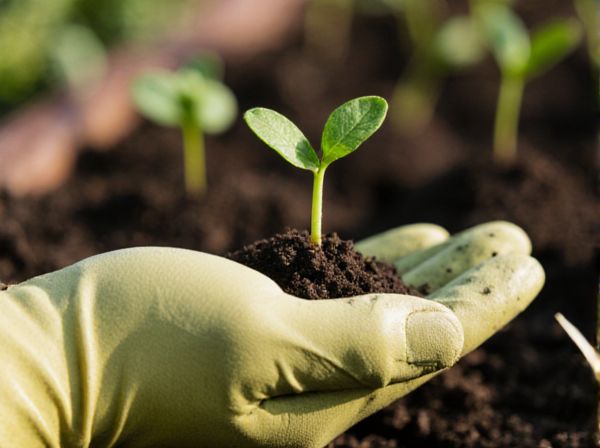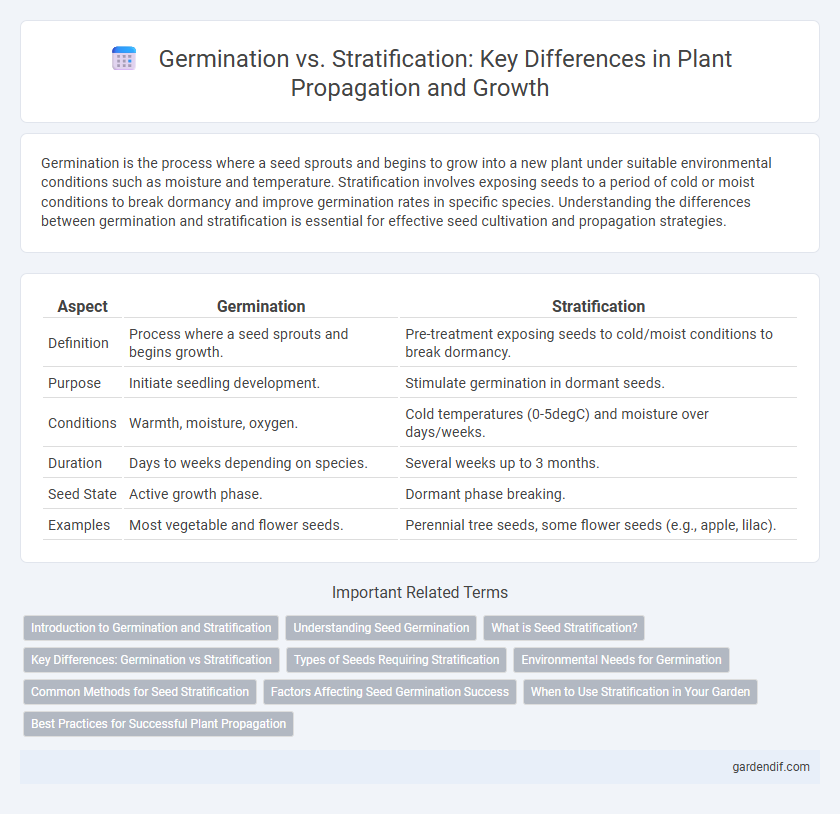
Germination vs Stratification Illustration
Germination is the process where a seed sprouts and begins to grow into a new plant under suitable environmental conditions such as moisture and temperature. Stratification involves exposing seeds to a period of cold or moist conditions to break dormancy and improve germination rates in specific species. Understanding the differences between germination and stratification is essential for effective seed cultivation and propagation strategies.
Table of Comparison
| Aspect | Germination | Stratification |
|---|---|---|
| Definition | Process where a seed sprouts and begins growth. | Pre-treatment exposing seeds to cold/moist conditions to break dormancy. |
| Purpose | Initiate seedling development. | Stimulate germination in dormant seeds. |
| Conditions | Warmth, moisture, oxygen. | Cold temperatures (0-5degC) and moisture over days/weeks. |
| Duration | Days to weeks depending on species. | Several weeks up to 3 months. |
| Seed State | Active growth phase. | Dormant phase breaking. |
| Examples | Most vegetable and flower seeds. | Perennial tree seeds, some flower seeds (e.g., apple, lilac). |
Introduction to Germination and Stratification
Germination is the process by which a seed develops into a new plant, initiated by water absorption and favorable environmental conditions such as temperature and oxygen availability. Stratification involves exposing seeds to a period of cold and moist conditions to break dormancy and enhance germination rates, particularly in temperate plant species. Understanding the distinct roles of germination and stratification is crucial for successful propagation and cultivation of various plants.
Understanding Seed Germination
Seed germination is the process by which a seed emerges from dormancy and begins to sprout, requiring optimal moisture, temperature, and oxygen conditions to initiate metabolic activity. Stratification involves exposing seeds to a period of cold, moist conditions to break physiological dormancy and promote uniform germination, commonly used for temperate species. Understanding the differences between germination triggers and the need for stratification ensures higher germination rates and successful plant propagation.
What is Seed Stratification?
Seed stratification is a pre-germination treatment that mimics natural winter conditions by exposing seeds to cold and moist environments to break dormancy. This process enhances germination rates for seeds with hard coats or physiological dormancy by softening the seed coat and triggering internal biochemical changes. Stratification is essential for many temperate plant species to ensure synchronized and successful seed sprouting in spring.
Key Differences: Germination vs Stratification
Germination is the process where a seed develops into a new plant under favorable environmental conditions such as moisture, temperature, and oxygen. Stratification involves subjecting seeds to a period of cold or moist conditions to break dormancy and enhance germination success. The key difference lies in germination being the actual sprouting phase, while stratification is a preparatory treatment to improve seed viability and germination rates.
Types of Seeds Requiring Stratification
Cold stratification is essential for seeds such as apple, cherry, and many deciduous tree species that require a period of chilling to break dormancy and trigger germination. These seeds possess physiological dormancy, which cannot be overcome by simple sowing and watering, unlike non-dormant seeds like beans or corn. Understanding the specific dormancy type and stratification needs of seeds like lilac, peony, and certain wildflowers ensures successful germination and healthy plant development.
Environmental Needs for Germination
Germination requires specific environmental conditions such as optimal temperature, moisture, oxygen availability, and light exposure to trigger seed growth. Stratification is a pre-germination process involving cold or moist treatment that breaks seed dormancy, simulating natural winter conditions. Understanding these differences helps optimize seed germination rates in agricultural and horticultural practices.
Common Methods for Seed Stratification
Common methods for seed stratification include cold stratification, which simulates winter conditions by exposing seeds to moisture and low temperatures typically between 1degC and 5degC for several weeks. Warm stratification involves keeping seeds in moist, warm conditions to break dormancy for specific species requiring a period of warmth before cold exposure. Mechanical scarification techniques, such as rubbing seeds with sandpaper or soaking them in water, often precede stratification to weaken hard seed coats and enhance water absorption during the stratification process.
Factors Affecting Seed Germination Success
Seed germination success is influenced by factors such as temperature, moisture, oxygen levels, and light exposure, which must be optimal to trigger metabolic activity in the embryo. Stratification, a process involving cold, moist treatment, breaks seed dormancy in certain species by simulating natural winter conditions, enhancing germination rates and uniformity. Seed coat permeability, hormone balance, and genetic traits also play critical roles in determining the effectiveness of germination versus stratification strategies.
When to Use Stratification in Your Garden
Stratification is essential for seeds with hard coats or those from temperate climates requiring a cold dormancy period to break germination inhibitors. Use stratification when planting species like apple, cherry, or lilac to mimic natural winter conditions, ensuring higher germination rates and stronger seedlings. Germination without stratification in these cases often results in poor or delayed seed sprouting, reducing overall plant establishment success.
Best Practices for Successful Plant Propagation
Germination requires maintaining consistent moisture and optimal temperature to activate seed growth, typically between 65-75degF for most species. Stratification involves simulating natural cold conditions by exposing seeds to low temperatures, usually 1-5degC, for a specific period to break dormancy and improve germination rates. Combining proper stratification techniques with controlled germination environments enhances plant propagation success by maximizing seed viability and growth potential.
Germination vs Stratification Infographic

 gardendif.com
gardendif.com